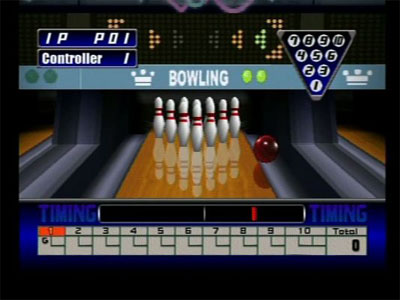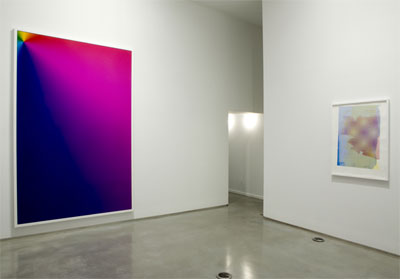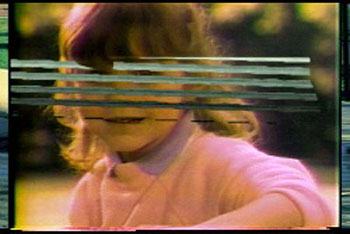
Humor has been a prominent but under-analyzed aspect of art in the past century; the comedy impulse is strongest in the history of media appropriation and conceptual art, beginning with Duchamp's poker-faced readymades and continuing through the work of Bruce Conner, Andy Warhol, Dara Birnbaum, Ant Farm, Jeff Koons and many others. Even the very way we talk about art overlaps with laff-lingo: we call certain pieces "one-liners," value work for being "wry" or "witty," and discuss whether or not a viewer "gets it." And of course, one of the first things someone will ask who doesn't "get it" is: "Is this supposed to be a joke?"
Cory Arcangel's work has almost always played on the logic of the joke in its construction: witness his most recent exhibit, "Adult Contemporary" at Team Gallery, which includes work like Self Playing Sony Playstation 1 Bowling (2008), an old bowling game hacked to only throw gutter-balls, and Permanent Vacation (2008 version), two silver iMacs set to email each other and exchange "out of office" messages until they fill up and crash. But the line between comedy and art more or less dissolved in Arcangel's related event at the New Museum's New Silent Series, Continuous Partial Awareness. In this stand-up-style routine, Arcangel performed an hour-long monologue by reading off a huge list of his unused ideas for new artworks, ranging from "give a boring artist's talk entirely through a vocoder" to "have intern watch Lawnmower Man 10,000 times and then make a website about all the plot inconsistencies."
At the very real risk of ruining humor by critiquing it, Cory and I meet recently to discuss the relationship between comedy and art in both his work and that of others. - Ed Halter
* * *
Ed Halter: Your event Continuous Partial Awareness is really convenient as a way to think about comedy in your work, because you've got all these ideas that can be analyzed together. So here's my take on how the jokes in your routine work. First, in each case you isolate a particular body of knowledge or mode of practice -- it could be broad like gaming, the internet, music fandom, or it could be very specific like the Guns N' Roses fan obsession around Chinese Democracy, or it could be aspects of the artworld. So each joke is based around one or maybe two of these very specific bodies of knowledge.
Cory Arcangel: Agreed.
And then you undercut the seriousness or utility of the practice by introducing some sort of absurd version of the typical way of doing things. And you do this in two ways, which are, interestingly, opposite. You either introduce a ridiculously enormous and therefore pointless amount of work into it, or you reduce the work by using automation, or defaults, or outsourcing. So you either extend the amount of work to an enormous extent that makes it absurd, or you reduce it to nothing which undercuts its legitimacy.
I think maybe sometimes that doesn't necessarily have to be opposites. If I'm extending something it's also deflating it just as much as not doing any work at all. So they're both kind of two different ways to get at the same result, sometimes.
I was thinking that happens in Untitled (Translation Exercise) (2006), where you had an Indian firm "dub" new voices into Richard Linklater's Dazed and Confused. You automated the procedure by outsourcing it, but then you extended it far beyond what was necessary to get the idea.
Yeah, I could have done five minutes. Do you know what the other title of that piece was? Lost in Translation. Which was vetoed because it was too "funny."
Vetoed by you?
Yeah, by me. Titles are difficult.
Were you afraid that the joke of the title would take away from the "joke" of the work?
Well I'll tell you why I extended it. The main reason why I wanted to do the whole movie was that I wanted it to play on its own humor. So I wanted people to come at it being like, ha ha ha that's kind of funny. But the idea was that, ideally, people would watch the whole thing and then it immediately becomes unfunny. The joke gets said so many times over that it ceases to become a joke and it kind of works better with the concept of the piece if its unfunny and painful and difficult.
-->Why is that?
Well the subject matter of that isn't necessarily so funny. Like, globalization, which I really don't have a political stance on, but I know I don't think it's "funny." That's why I felt I had to do the whole thing. I had to put in an enormous amount of work to at least hint at the fact that this wasn't actually funny. And the way to get at it not being funny was by using humor, oddly enough. Then naming it Lost in Translation would have started it off on the wrong foot.
So do you think that by introducing these absurd levels of work -- extending or reducing -- are you trying to undercut the work of the artist?
I don't know -- it's more gray than that, because the art context assimilates things so quickly. So "undercutting the work of the artist" is immediately assimilated as the new work of the artist, so I would say that I don't have that agenda. I'm definitely playing with it but I feel like that's futile -- it's not worth the effort.
Well after I thought about looking at the humor in your work as having this structure, I quickly realized that this formula isn't unique to you. You can look at a lot of post-conceptual work that is funny, and it works in similar ways. It seems to be very much in mode now to stress the humor, the prankishness, in conceptual practice rather than the more serious philosophical implications. So maybe when we look at, say, Lawrence Weiner today, we may now be more drawn to the absurdity, or his wit, rather than the more serious issues he's proposing. But of course there is a great deal of seriousness in early conceptual art.
Which is very difficult to relate to.
Well people still do it, but very often with younger artists you see it done with these undercutting gestures, which have also been assimilated into the idea of what it means to be an artist.
Yeah as soon as you do it...I don't have any grand scheme. I mean, that performance [Continuous Partial Awareness] -- even though I planned a lot of what I was going to talk about, much of what I did was just off the top of my head. Coming out of like, performance pressure, in the moment, where I can see the audience, which is more like a comedy pressure. So what I'm saying is what I decided to talk about that night was based on what I thought people would think was funny, which I was trying to calculate in real time. So if the audience was in such a way where I thought the opposite thing was funny, I would have done that. It's much more flexible.
So, thinking about comedy as more about this relationship between the audience and keeping in time with their sensibility?
Yeah.
But the opposite of this would be when you did a set of Jerry Seinfeld jokes, from memory, at a real comedy club, which reportedly bombed really hard. Did you intend it to be unfunny, or did you even know what was going to happen?
I thought people would think it was funny! Because I don't know anything about the comedy scene at all, you know, so I had a naïve view that there would be people in the audience who were on a similar wavelength and it would go down pretty OK. Like I thought there would be people in the audience who would go, yeah man that was pretty funny. But it turned out it was an open mike that was mostly a bunch of comedian friends, and they were doing what they need to do to establish a career and work on material. They were intensely involved in what it means to be a young comedian in New York and me kind of gate-crashing it -- I didn't see that dynamic until I was up on stage, and then it became really difficult.
Did they recognize what you were doing in terms of the Seinfeld routines?
I told them right away, and they just groaned, and it wasn't like a funny groan. I think maybe to them [the idea of] Seinfeld just isn't funny. But to me the whole idea of Jerry Seinfeld is hilarious. But then again one guy did come up to me after and say it was really funny, so maybe it wasn't a total loss.
But maybe that audience wasn't the true audience for it. The real audience came later, at the New Museum, when you told the story about it happening.
It all depends on who the audience is or what the context is. At one level comedy is for the masses whereas art...well it's difficult to say because now with the internet, the internet is like a line-drive right down the fairway of context.
The internet also allows for a lot of different kinds of inside jokes. Like when you told the one about getting Zen Home Cleaning for the La Monte Young Dream House --
Yeah, there were only like four people who got that one.
A lot of the jokes are like that. I mean, in your mind everybody is obsessively waiting for Chinese Democracy, but actually that is still a very specific group.
That's why that performance had to have a lot -- I had to have like 50 ideas or a lot so I could slowly make my way to everybody who might be in the audience. I had music composition jokes, a lot of minimalism jokes. The Zen Home Cleaning -- that's one I really thought was funny. Because I went to the Dream House and I thought, you know, this place really needs a little bit of a clean-up.
It would smell nice too, afterward.
And they'd have a little candy bar next to the oscillator that has been droning for thirty years.
So a lot of your jokes are inside jokes, but you have a lot of different "insides" that you are playing to.
It is a big problem of being an artist who works on the internet, because the internet does give you access to a larger public, so I think probably one of the hardest things it is to have a bent toward humor and to be an artist who works both on the internet and in an art context. There is this sliding scale of audience, and it's very confusing.
So let's think about -- where would you draw the line, to put it one way, between Andy Warhol and Andy Kaufman? Where does one leave off and the other begin? When you went into that comedy club to do the Seinfeld routine, it seemed a line was drawn. Or perhaps it was just that particular gag -- maybe another type of gag would have engaged that audience.
When I was thinking about it I was like, oh yeah, Andy Kaufman, there's a whole history of this, I'll just be welcomed with open arms. My favorite thing he ever did was the Mighty Mouse thing, which I think I've been copying for like fifteen years.
How so?
Well think of the Born to Run Glockenspeil Addendum (2006). When I was making that, I was thinking about Andy Kaufman's Mighty Mouse thing. And Super Mario Clouds (2002) too.
How's Mario Clouds like his Mighty Mouse routine?
Well his Mighty Mouse routine was basically playing the song and only singing along to one tiny part of it. So basically stripping away all of the content except for one tiny part of a piece of media. I mean, god, I've made that project thirty times over. But his joke doesn't actually work the way mine did. I mean, his joke is actually very funny, the way he acted it out, but it's similar. His is more comical because of the over-the-topness of the part that he sings. And his main persona at that time was that meek, very quiet almost "mousey" guy, and to have him do that huge thing -- it's pretty incredible. So I've basically been re-making that Andy Kaufman piece as long as I've been making artwork.
When did you come to the realization that that Kaufman piece was the key to thinking about what you've been doing?
Since I've been making things. This was like probably even before high school. That particular thing was an obsession. But yeah, where is the line between Andy Kaufman and Andy Warhol? Where does one start and the other begin? Because a lot of what Andy Warhol did was very funny. I think about his like second show in LA that was just those giant double Elvis, triple Elvis. That's pretty funny.
And also automating the work of the artist: joke's on you, Gerard Malanga! But you could also think about what is the line between your event at the New Museum and The Technology Readings event at the same space. If you think about Chelsea Peretti's or Amy Poehler's routines, they also did jokes about technology -- insider jokes playing to what they were perceiving to be a tech-savvy audience. So what makes them comedians and you an artist? How do you draw line there -- is it merely which professional circles you move in?
It's funny, because the first night I every performed in front of a comedy audience was an invitation from Chelsea to perform at her night Variety Shack, which is a variety comedy show. When I did that for the first time, I did a Simon and Garfunkel routine that I had done previously in museums [Old Friends aka Simon and Garfunkel "Live @ Central Park" DVD timecode for all the places where a liberal reading could indicate tension between Simon and Garfunkel (2004-5)], so I had tested it out and knew it was pretty funny. Then I did the same exact routine in front of a comedy audience, and it went like 800 times better. I was shocked at how much better it went. So that situation is still confusing to me. So, where is the space for this stuff? Sometimes it's hard to say. My New Museum performance, a lot of that stuff -- the minimalism stuff, the La Monte Young stuff -- that wouldn't play outside of the museum. But some of those other jokes, and what makes me an artist, I don't know. I put the majority of my works in an art context, which isn't a decision I made. I mean, people kept asking and I kept saying yes.
And it's an art world that has expanded now to the point of having a conceptual practice that allows for that.
Yeah, totally, but there are still certain ideas I have that...I mean, Continuous Partial Awareness is the easiest thing of mine to associate with comedy, but think about the show I had at Team Gallery. For me, a lot of that artwork is pretty funny, but it's funny only if you know about other things that are in galleries. I mean the huge Photoshop gradient for me is pretty funny, and the really crappy silkscreens are kind of funny [Photoshop CS: 110 by 72 inches, 300 DPI, RGB, square pixels, default gradient "Spectrum", mousedown y=1098 x=1749.9, mouse up y=0 x=4160 (2008), Monoprints (1 thru 5) (2008)].

I was thinking about that show particularly. The upstairs stuff is all art-world jokes. Do you think you've shifted to having more jokes about the art world as you've become more a part of it?
I think that a lot of what's in the upstairs are me trying to finally fine-tune the context for my pieces. Because I think a lot of times I put something in the gallery that could also work on the internet. For me that sometimes gets kind of confusing -- not for any sort of reason other than just conceptually. It's this whole idea of where do you place your work, because the internet is so open now. And some of the ideas -- I could just do stand-up. Some of the works for the upstairs were me picking some of the ideas I had and elaborating on the ones that can only show in the gallery. So, yeah, I guess I'm trying that out in a way to make more clear what I'm doing.
I think it might be interesting to compare the humor in your work to that of another artist, Seth Price.
Seth Price is very funny.
For example, you have a piece where you add dust and speckles using Final Cut Pro defaults, then print the video onto 16mm -- you're redoing Nam June Paik's Zen for Film (1964) but automatized.
That was an old one, but the new piece in the Team show is like a fake avant-garde film [Personal Film (2008)]. It's very similar.

So that piece also combines an absurd use of defaults (keeping the Final Cut Pro countdown logo), readymade-ness (using video of film footage you found online) and an inordinate amount of work: why transfer a video onto 16mm film, which is a relatively expensive and complicated process?
Yeah, like "why even bother?"
Seth also had a piece [Film, Right (2006)] that involved transferring video to 16mm film, where he took this footage of stock-video "gak" and he transferred that to 16mm. So maybe we could talk about comparing those two. They're very different kind of "jokes," if you want to call them that.
Seth, I think, was trying to get more at the mobility of images. He did that in a show where the other piece in the show was the same -- one video on film [Film, Left (2006)] and the same video on VHS sold at EAI [Digital Video Effect: "Editions" (2006)]. So he was getting at the idea of how do images move through the system that is set up -- the art system but also the internet. So I would read that as a joke on the systems that are set up to distribute art.

There's a great quote I have here in an article by by philosopher Simon Critchley on humor. He quotes anthropologist Mary Douglas, who wrote, "A joke is a play upon form that affords an opportunity for realizing that an accepted pattern has no necessity."
Yes, exactly. So that would be the perfect way to describe what Seth is doing to the system of how video and images are moving around today. And I would say that mine would be a similar description to the way that traditional avant-garde [film] is slowly being assimilated into contemporary gallery culture. . That was the joke basically: this is fake, and I was too lazy to do it for real. It looks "cool," it looks just like it should look. It looks like "art" now -- because the art world is suddenly discovering avant-garde film.
I also took it as a comment on the fact that some 16mm stuff that is circulating in the artworld is not that great, but you can look at it very quickly and say, "oh, it's a handmade film."
Well, it’s cool with me if other people are making handmade films, but I wanted to play with film as "style". So like, if people are walking through my show, I want them to get the feeling that it's a handmade film -- but it's fake. This kinda plays on the currency film has, and hopefully also undercuts the legitimacy of film itself at the same time because I put no effort into really learning anything about hand making films.
So why do you think comedy, or humor at least, is so much a part of new internet art? Or for that matter, old internet art. There have always been net art pieces that are funny, prankish -- I mean, think of that old Jodi piece where you pull up the code and its a diagram for an atomic bomb. That's funny. Or nowadays with these younger artists who always seem to be engaged with the concept of: "ah, isn't it funny that I'm doing this?" So why do you think that humor has been such a big part of internet art?
I think it's the potential audience and the level of stuff that goes on. Sometimes I think when you upload something and it's not funny, it's like, what’s the point? Because there won't be an audience for it. I just think it's the currency of the internet.
You could upload things that are beautiful or at least "cool." Petra Cortright's work isn't really about being "funny" -- in many cases it is more about beauty and craft. But more often then not, new net art seems to want to be funny.
That's a good point about things not always having to be funny, but as for things that are, I don’t know why that is. Why is it that the idea of the internet is now America's Funniest Home Videos? An entire culture is now based around basically what we were watching in that show. What happened -- how did the tables get turned? And then it's funny now because now something will get so funny on YouTube it will get sucked back to television. Why that is, I don't know.